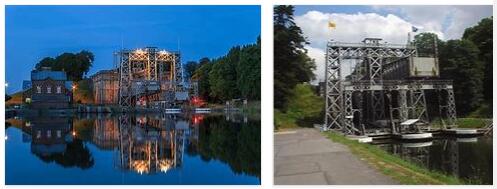
The four hydraulic ship lifts between Houdeng-Goegnies and Thieu are outstanding industrial monuments of the 19th century. Each of these lifts overcomes a gradient of 17 m and works from a single source of energy: water.
Canal du Center boat lifts: facts
| Official title: | The four boat lifts of the Canal du Center |
| Cultural monument: | overcoming a height difference of 67 m with four boat lifts; With the construction of the new Strépy-Thieu lift, it no longer has any significance for European shipping, only tourist use to preserve the industrial archaeological heritage |
| Continent: | Europe |
| Country: | Belgium, Wallonia Region, Hainaut |
| Location: | Thieu, Houdeng-Aimeries, Houdeng-Goegnies, west of La Louvière and east of Mons |
| Appointment: | 1998 |
| Meaning: | Example of the industrial culture of the late 19th century; Of the original 8 hydraulic lifts in Belgium, these are the only ones still preserved |
Canal du Center boat lifts: history
| 1871 | Decision to build the Canal du Center |
| 1879 | Legislation for the construction of the Sambre-Scheldt link |
| 1888-1917 | Construction of the Canal du Center |
| 1978 | Founding of the Compagnie du Canal du Center for the tourist development of the Canal du Center and for the preservation of the historic boat lifts |
| 1982 | Construction of the new Strépy-Thieu boat lift |
| 1992 | placed under monument protection |
| 2002 | Replacement of the four lifts with the new Strépy-Thieu lift |
Mammoths of the “modern iron age”
Lifting ships hydraulically from level to level – that is an idea of the »modern Iron Age«, but by no means the first one. Decades before the idea of allowing ships to travel continuously on the Scheldt and Sambre by means of lifts in Wallonia, in the south of the newly formed state of Belgium, emerged as the landmark of the first world exhibition, the Crystal Palace, which was launched in London in 1851. built from glass and cast iron, largely prefabricated in standardized components. The industrial palace at the Paris World Exhibition, which took place four years after the first exhibition of this kind, also paid homage to the “new” building material iron. Although the historicizing exterior of the Palais d’Industrie resembled a palace, But inside was a huge iron structure with a 192 meters long and 48 meters wide central nave and a cantilevered barrel-shaped iron and glass roof. The Eiffel Tower, built in 1889, became the ultimate symbol of the industrial age of the 19th century.
In the “modern Iron Age”, for example, the decision was made to facilitate the connection between the Scheldt and the Sambre by means of water-powered ship lifts. At that time, this area between Mons, La Louvière and Charleroi was an economically emerging region thanks to coal and pig iron, where hard physical work determined the everyday life of the people. In a letter to his brother Theo, the painter Vincent van Gogh, who lived as a preacher and carer in the Borinage near Mons from 1878 to 1880, wrote: “The workers there are mostly emaciated and pale with fever and look tired and emaciated, weathered and aged prematurely. ”
But people who have grown up with iron, steel and coal for generations are now among the losers of modernization. Coal, iron and steel have long been mined and produced cheaper elsewhere. And the inland waterway operators who travel between the old industrial districts of Hainaut to Brussels and Antwerp survive only poorly in the face of competition from the road. A working day of more than twelve hours is not uncommon for Benoise, the owner of the »Marie Rose«. However, he no longer takes the route through the old boat lifts of the Canal du Center, but uses the new lift at Strépy-Thieu. This saves time: Benoise needed four instead of two hours for the passage via the old ship lifts.
The Canal du Center, which is part of the extensive canal network in Belgium according to politicsezine, which was largely completed at the end of the 19th century, is now mainly used by the Compagnie du Canal du Center for tourist boat tours. This project is intended to help reduce the above-average unemployment rate in this region of Belgium – an attempt, similar to those in other abandoned industrial areas in Europe, to achieve a lasting revitalization with the help of tourism and thus to preserve the industrial archaeological heritage.
The towpaths to the left and right of the canal are now used as hiking and biking trails. There is no more groaning to be heard today, no moaning from those who for years pulled the ships across the water with their mere muscular strength before strong cold-blooded horses dragged the heavy load. Only in the paintings of the Belgian “social realists” – such as Pierre Paulus and Constantin Meunier – one learns of the hard fate of the miners and inland waterwaymen. But the ship lifts are still a masterpiece of engineering – an achievement that would never have been possible without Hector Genard. Even if they are not the oldest in Europe and their iron construction does not look as filigree as the Eiffel Tower in Paris, these lifts are something special, If only because for decades they have lifted the ships with weights and counterweights without any defects. And only a few lifts of this type have survived anywhere in the world.